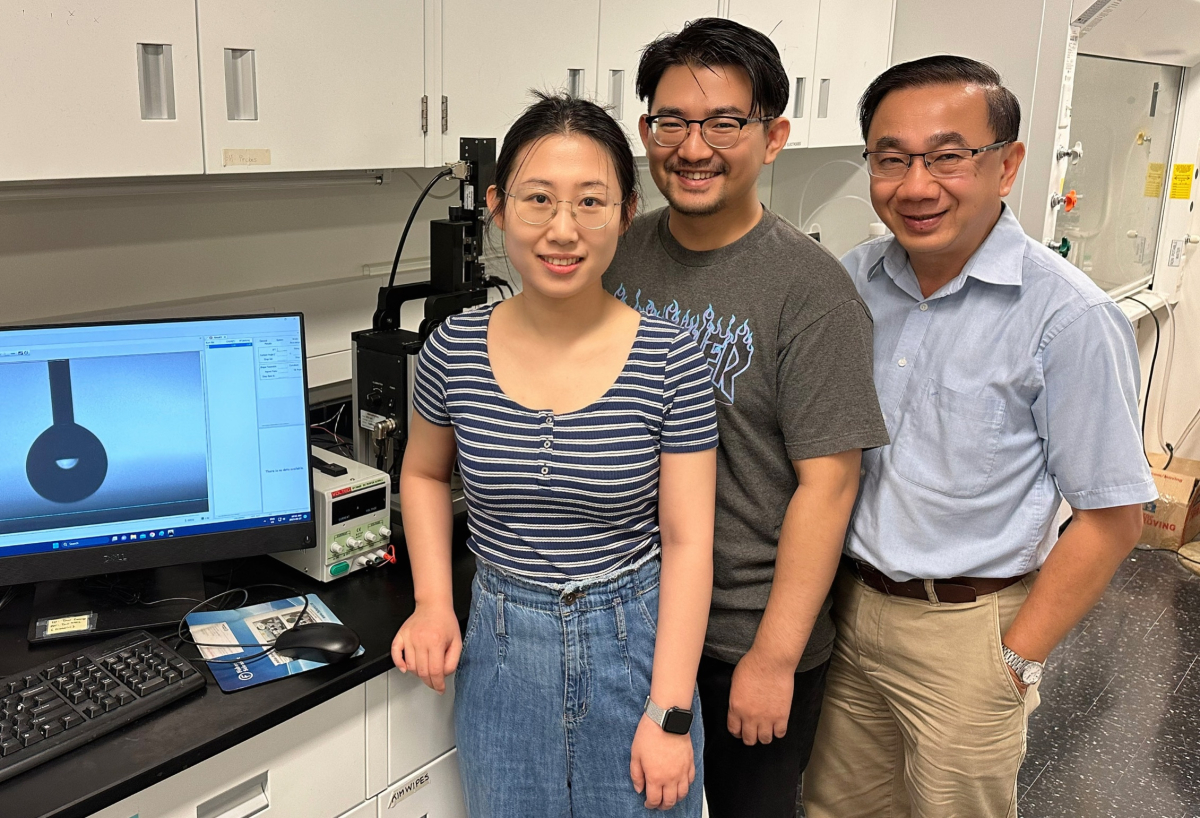Support strong Canadian climate journalism for 2025
Water scarcity is a pressing global challenge, and researchers at the University of Waterloo are turning to insects for inspiration to address the problem.
A research team at the university has developed technology inspired by spiderwebs and Namib desert beetles, both of which capture moisture from the air and convert it to fresh water.
The research is led by Prof. Michael Tam, University Research Chair in the chemical engineering department, and two students, Eva Wang and Weinan Zhao. The team aims to use the techniques perfected by insects and upscale them to deliver larger volumes of water for society.
Tam told Canada’s National Observer his technology uses plant waxes, pollens and cellulose nanoparticles to produce an emulsion (a mixture of two or more liquids that are normally unblendable) that is sprayed onto a smooth glass slide to produce a textured surface. When water droplets encounter the specially engineered surface, they nucleate, or grow into larger droplets, which accumulate and drop as gravity kicks in, said Tam.
All the materials used are sustainable and derived from natural sources, and minimal energy is needed to capture the water droplets, he added.
“The surface regenerates and refreshes itself, and cleaning is typically not necessary. It is the same concept as to how spiderwebs and the back of beetles capture water.”
“There are many communities that are living in regions such as mountains, deserts, remote islands where there are no rivers or lakes or access to fresh water,” said Tam. “The atmosphere contains water in the form of fog, dew and water vapour.” Mimicking the way spiders and beetles draw water from these environments can help those communities find a sustainable water source for themselves, he explained.
"A spider's web is an engineering marvel," said Tam. "Water is efficiently captured by the web, allowing the spider to obtain moisture without needing to travel to a river.”
Namib desert beetles also have evolved to thrive in their arid surroundings by using their textured body armour to capture tiny droplets of water from the fog, Tam added. This ingenious strategy enables them to amass moisture, which subsequently drips into their mouths, sustaining their survival in a water-scarce environment.
Humans have traditionally relied on collecting water from rivers, lakes, the ground and oceans, often requiring extensive treatment processes. However, as freshwater sources become increasingly stressed due to population growth and climate change, innovative solutions will be needed to ensure there is enough water in the future.
“We can capture five litres of water per hour for one square metre of surface. We are now developing foams with high surface area in a small volume to scale the process so that it can be used efficiently for communities that need water to survive,” said Tam.
Using a similar concept, Tam and his team are also developing low-energy dehumidification technologies for buildings and homes.
With 20 per cent of the world’s freshwater reserves, Canada has abundant lakes and rivers and recognizes the importance of fresh water as a vital natural resource. As climate change and pollution threaten these waters, the federal government is making efforts to safeguard their quality and availability. Budget 2023 invested in the creation of the Canada Water Agency, headquartered in Winnipeg. This agency will collaborate with various stakeholders to ensure a safe, clean and well-managed water supply for all Canadians.
The University of Windsor is also contributing to freshwater research through its involvement in the Real-Time Aquatic Ecosystem Observation Network, supported by over $1.77 million in funding from the Canada Foundation for Innovation.
This story was produced in partnership with Journalists for Human Rights for the Afghan Journalists-in-Residence program funded by the Meta Journalism Project.






Comments
“…both of which capture moisture from the air and convert it to fresh water.”
Convert? I think the captured moisture is already fresh water, save for whatever pollutants may be hitching a ride.
“Humans have traditionally relied on collecting water from rivers, lakes, the ground and oceans, often requiring extensive treatment processes. However, as freshwater sources become increasingly stressed due to population growth and climate change, innovative solutions will be needed to ensure there is enough water in the future.”
Why does this article resemble , so much, an advertorial?
Further, freshwater sources are also becoming stressed because in the case of, for example, groundwater, the aquifers have been overexploited for decades, and that’s not only a function of population, but a function of mismanagement (not even knowing how much water is there and not tracking or regulating usage) and poor choices (creating cultural and agricultural civilizations in deserts; choices in what plants are grown, and for what purpose; e.g. alfalfa in the US SW for export, cotton.).
“We can capture five litres of water per hour for one square metre of surface.”
This is terrific, really, but missing is some important contextual information to allow the reader to assess, to a limited degree, the claim. Are five litres per hour captured in desert-like conditions?
A few data points that could have been provided, to make this more useful, I’ve captured in the following sentence:
“This is with ambient air conditions of X degrees, and a relative humidity of Y, with a collection surface temperature being Z degrees.”
I’m a proponent of biomimicry, but I’m chagrined by the seeming increasing credulity (or, perhaps, simply slipshod-idity) of journalism.